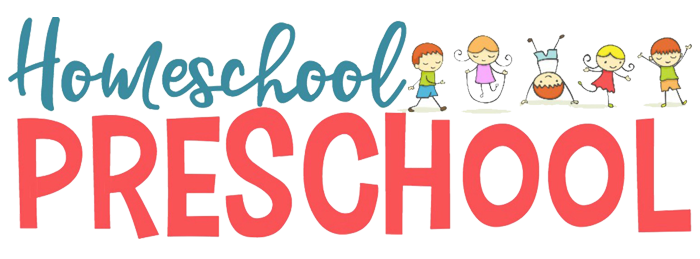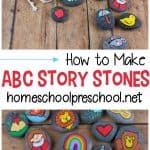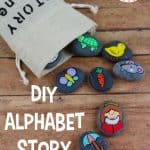Alphabet Story Stones
Have you ever tried alphabet story stones as a part of your alphabet activities for preschoolers? These magical little tools can transform the way younger children learn and interact with letters.
Alphabet stones are fun, tactile, and visually appealing, providing a great way to teach the essentials of language. These hand-held treasures can turn a simple alphabet activity into an exciting story-building session, sparking creativity and imagination in young minds.
Using alphabet story stones, you can introduce a new dimension to learning, making it a delightful experience for your preschooler. They’ll make a great addition to your preschool activities.
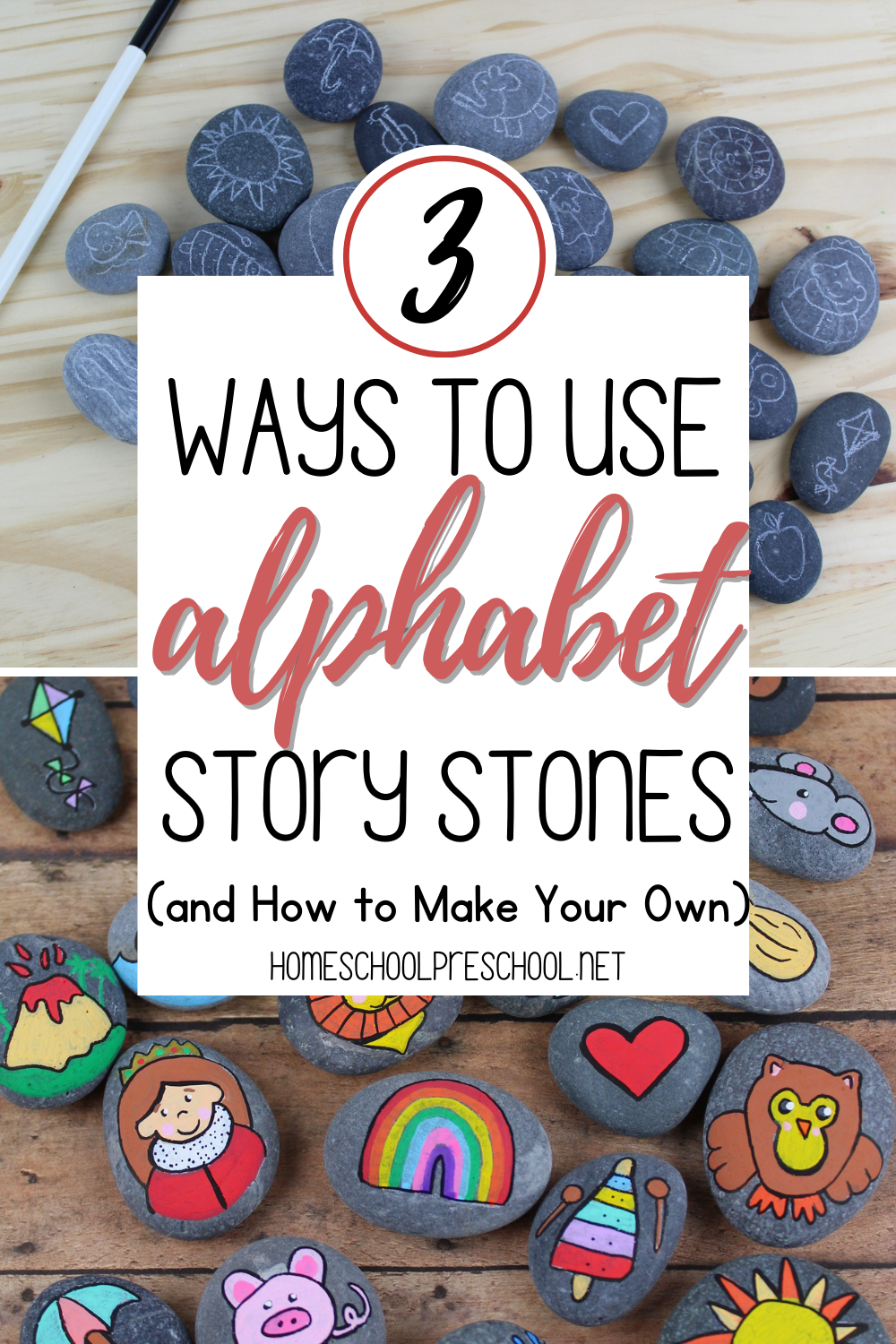
There are endless possibilities when it comes to using these homemade story stones with young children. From sorting and identifying beginning sounds to exploring various language concepts and beyond, your kids will absolutely love the immersive learning experience that these beautifully painted rocks provide.
Alphabet Story Stones
While I call these story stones, they really can be used in a myriad of creative ways. Kids can utilize them to engage in imaginative storytelling, practice identifying beginning sounds and alphabetical order, enhance their sorting skills, and so much more.
In this post, we will delve into the step-by-step process of making these your own story stones. Once you have created them, we’ll explore the various ways you can incorporate them into your activities with your kids, sparking their curiosity and fostering their learning journey.
What You’ll Need
You can find many types of stone in nature, or you can purchase some flat stones at your local craft store. I got the rocks pictured here at the hardware store.
If you use dark rocks, like the ones pictured, you’ll want a white pencil to draw the images. If you use light rocks, you can use a regular pencil or a thin permanent marker.
To paint your rocks, you can use paint pens or acrylic paint and a thin paint brush. It’s totally up to you.
What You’ll Do
To start, wash and dry your rocks to get rid of any dirt and debris that may keep the paint from sticking. With a pencil, outline your images.
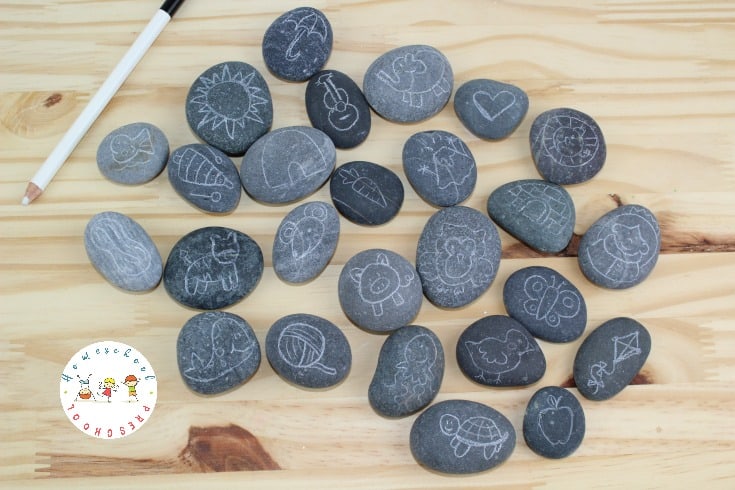
Once you’ve got all of your images drawn, begin painting them. I prefer to use paint pens, but you can use acrylic paints if you wish.
Once the initial layers of paint are dry, go back and outline your images with a black sharpie or paint pen.
If you’d like to seal your stones, I suggest using matte mod podge. But, wait until the paint is dry before sealing or your images will smear.
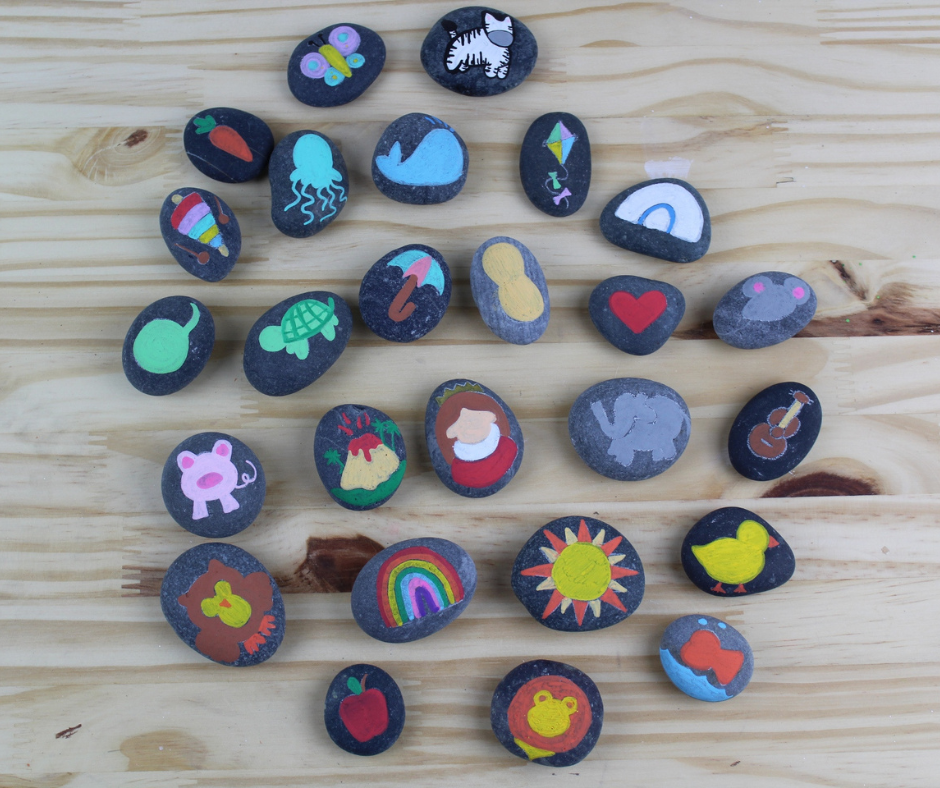
Different Ways to Create Story Stones
If you’re not too artistic, don’t worry! You can still create a beautiful set of story stones using various materials like stickers, magazine pictures, or even old book pages.
Simply choose your desired image and glue it onto the stone or carefully stick on the stickers. To add a protective finish and give it a glossy look, seal the stone with a layer of mod podge.
With these simple steps, you’ll be able to transform ordinary stones into unique pieces of art! This is an easy way to make a large collection of story stones for your preschoolers.
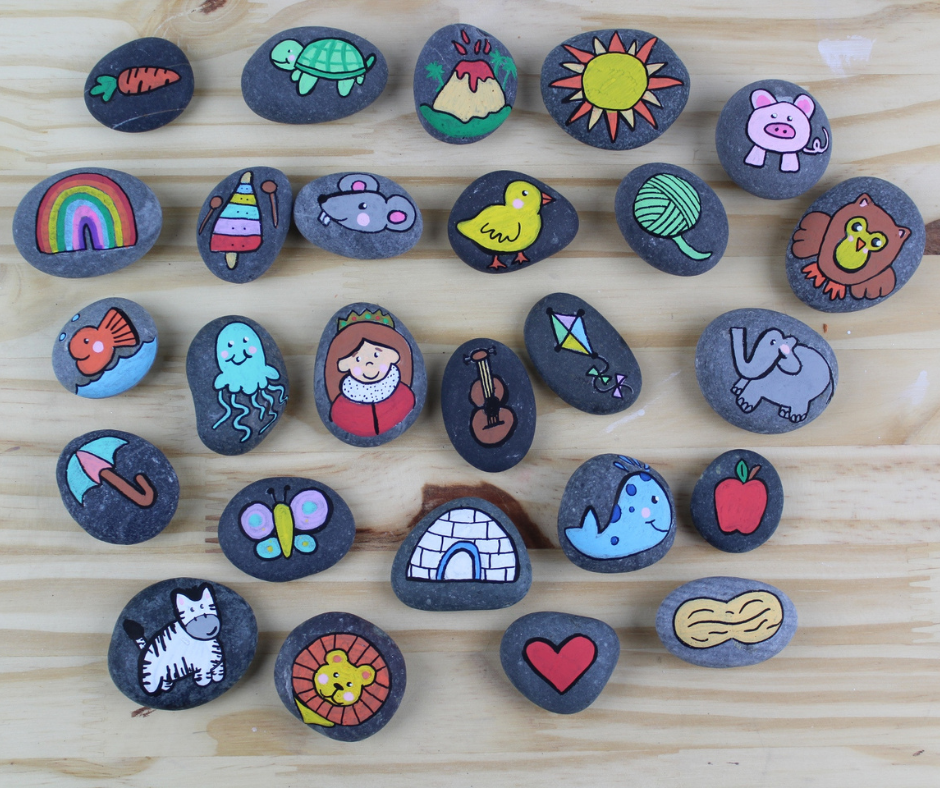
How to Use Story Stones
As I mentioned above, there are countless hands-on ways to use story stones with young students. From engaging storytelling sessions to fostering early literacy skills, you can explore a variety of exciting activities with your little ones.
Let their imagination soar as they create and share stories using these captivating story stones. Enjoy the journey of learning and discovery together!
Creative Storytelling
Put the story stones in a basket. Have your child choose a stone and use it to begin a story. Then, choose another stone and add on to the story. This can be done individually or in a group setting.
In a group setting, one child chooses a stone and starts the story. Then, another child chooses a stone and adds to the story incorporating the picture on the stone.
Continue until all the stones have been used or all of the kids have contributed to the story.
Letter Sound
Grab a pack of letter magnets or alphabet flash cards and turn learning into a fun way for your child to engage! Have them match the stones to the same letter as their beginning sound, making it an enjoyable and educational activity.
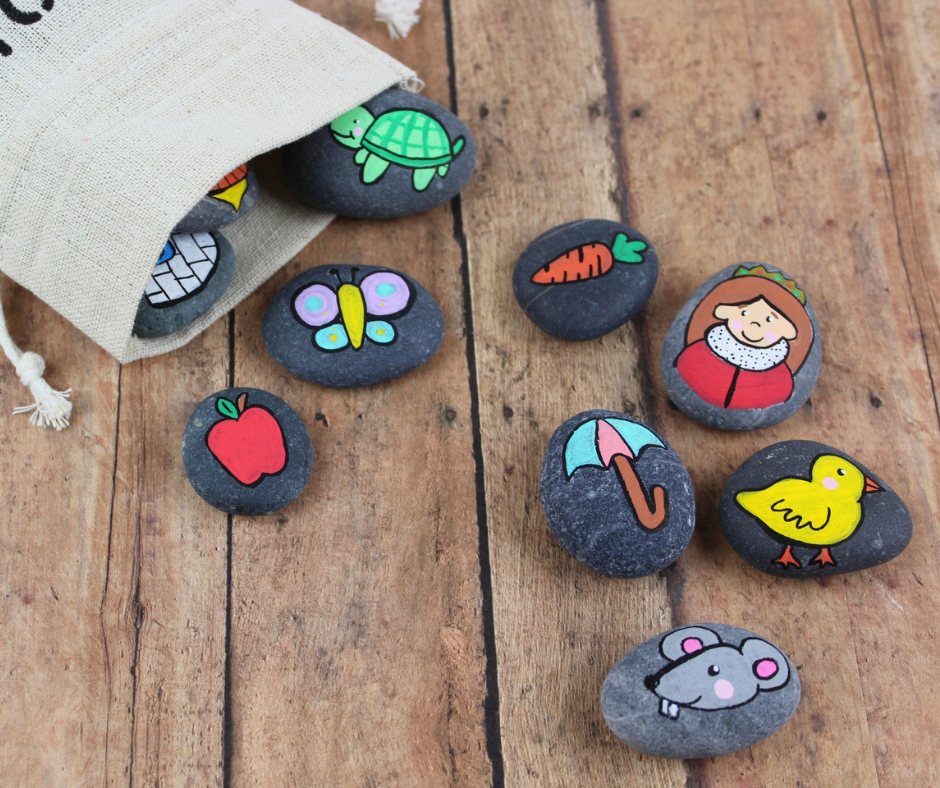
Sorting and Grouping
The perfect way for kids to engage with learning is by sorting and grouping stones based on chosen characteristics. They can start by sorting animals and non-animals and then group them by their main color. Encourage your child to choose a characteristic and then check their work. It’s an excellent opportunity for them to develop critical thinking skills and have fun at the same time!
Imaginative Play
Story stones can serve as a wonderful catalyst for creative play. By selecting one or more stones at random, children can create unique, often fantastical stories completely sprung from their own imaginations. For example, a child could pick up a stone with the image of a castle, and another with a dragon, and construct an adventurous tale of a brave knight defending his kingdom. This great idea not only fuels their creative thinking but also empowers them to express their narratives in their own words. Furthermore, the tactile nature of the stones enhances the sensory aspect of play, making the experience more engaging and memorable.
Sensory Play
Alphabet story stones introduce a multi-sensory dimension into the learning process, making them an excellent tool for sensory play. Sensory play revolves around stimulating children’s senses, and the tactile elements of alphabet story stones cater to this perfectly.
The stones can be used in a sensory bin filled with sand, rice, or any other safe material. This allows children to explore and discover the stones, enhancing the sensory experience further.
The weight, texture, and temperature of the stones add to the tactile elements, making alphabet story stones a versatile and effective tool for sensory play.
Related Activities for Alphabet Learning
Apart from story stones and alphabet books, several other engaging activities can assist in alphabet learning. Here are some of our favorites:
Alphabet Puzzles: These are excellent tools for developing letter recognition and fine motor skills. You can find a variety of puzzles featuring both uppercase and lowercase letters.
Letter Matching Games: These games promote visual recognition of letters. Children can match uppercase to lowercase, or letters to their sounds.
Alphabet Bingo: This classic game can be a fun way to learn the alphabet. It helps develop the recognition of letters and listening skills.
Interactive Apps: In today’s digital age, there are many educational apps designed to make alphabet learning fun and interactive. For example, apps like Starfall or ABCmouse offer engaging games and activities involving the alphabet.
Remember, learning the alphabet is a foundational step in literacy development. By incorporating these activities into your child’s routine, you can make this process engaging and enjoyable.
Additional Teaching Resources
This wooden alphabet board is double-sided with upper and lowercase print letters. It’s great for ages 2 and up for letter identification and letter formation. This board can be used with the included walnut “pen” or traced by finger. Makes a wonderful handwriting tool for at home or in the classroom.
These hand painted rainbow alphabet rocks can do all sorts of things! Add them to a sensory bin, use them for loose parts play, put them in a writing center in the classroom, and much more!
Frequently Asked Questions
What age group is appropriate for story stones?
Story stones are generally suitable for children aged 3 and up. However, it’s crucial to ensure that the stones are large enough to avoid choking hazards for younger kids.
Can story stones be used for other subjects apart from literacy?
Yes, story stones can be adapted to teach a range of subjects. For example, you can create stones with shapes, numbers, or colors for early mathematics learning.
Are there any other materials I can use if stones aren’t available?
Absolutely! You could use pieces of wood, cardboard, or even thick fabric if stones aren’t readily available. The key is to have a solid surface where images can be adhered.
How can I integrate story stones into a daily routine?
Story stones can be used during dedicated learning time, or integrated into playtime. They’re a great tool for bedtime stories, where your child can help craft the night’s tale. They can also be used as a quiet time activity.
What if my child is not interested in story stones?
That’s okay! Every child is different. Try introducing them slowly, or using different images that you know your child is interested in. If they still don’t show interest, they might just not be ready yet or prefer other learning tools. The key is to keep learning fun and stress-free.

The value of incorporating story stones and alphabet books into your child’s educational journey cannot be overstated. These innovative tools can contribute significantly to their literacy development, foster their creativity, and strengthen critical thinking.
Equally important, they introduce a fun and interactive aspect to learning that keeps young children engaged and eager. Remember, every child has an innate capacity to learn and grow, and with the right resources, their potential is limitless.
